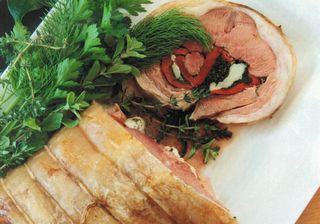Lamb for Easter Celebration
A delightful little book “Capon on Cooking” by a rather unusual American Episcopal priest who contributed culinary advice in the New York Times and Newsday magazine, has this to say about Easter...

A delightful little book “Capon on Cooking” by a rather unusual American Episcopal priest who contributed culinary advice in the New York Times and Newsday magazine, has this to say about Easter:
“When it comes to celebrating Easter, household cooks have long known what the church has only rediscovered. The celebration cannot be confined to Sunday alone: it pervades even the somber events of the week before…Easter dinner, like the resurrection itself, had to be in the works long before the event. God might raise the dead, but his miracles stopped short of supplying meals on wheels for Sunday afternoon.”
Rev Capon also points out: “Easter does have one advantage (over Christmas), however; its celebration focuses on only two things, Food and Faith. By contrast, when Christmas finally rolls around, you can hardly even see the tree for the woods of commerce and busyness.”
Your faith, we leave to you, but the food side of Easter is important in many households.
Lamb was the traditional Easter meal, associated with the Jewish Passover, while the Easter egg symbolises the resurrection, although these days they have a distinct commercial flavour! There is a Ukrainian folktale that has Simon of Cyrene, who helped Christ carry the cross, as a seller of eggs – and when he returned to retrieve his produce, his eggs had been transformed; painted with bright colours and beautiful designs.
The origin of the Easter egg is thought to be based on the fertility lore of the Indo-European races and it became a symbol of Spring. Eggs were given as gifts to servants and to children.
Perhaps the most famous eggs are those made for the Russian tsars by Fabergé – jewelled and enamelled and nowadays worth a fortune.
In the Middle Ages, lamb was the customary Easter meat, turning the sacrificial Passover lamb into the Christian Paschal lamb – Christ as the sacrifice. In times past, meeting a lamb, especially at Easter, was thought to be lucky and it was popular superstition that, because of its religious symbolism, the devil could never appear as a lamb, although he could take the form of all other animals. Easter baskets were brought to church on Easter Sunday, filled with special breads and eggs.
As for the Easter bunny – it had nothing to do with Easter, really, merely having been seen as a symbol of the fertility of spring. Pork, too, is a traditional Easter meat in some places. There are also Easter breads and cakes in different countries, including the best known here – the hot cross bun, which started out with the Saxons who ate it in honour of the goddess Eostre. The Simnel cake was part of the feasting after Lent, decorated with marzipan.
Try some of these lamb recipes for your celebratory Easter meal – and they’ll taste just as good at other times of the year. Apricot And Rosemary Loin of Lamb, German-style Roast Leg Lamb With Roast Pumpkin Salad are just a little different. Or you could go Mediterranean with the likes of Ras-el-Hanout Lamb Shanks or Greek Scented Rack Of Lamb With Orzo Salad, while Moroccan Lamb Rump With Roasted Pears And Quince Jus is the perfect sized roast for two people. Devilled Lamb is delightfully spicy while a more traditional approach is taken with French Leg of Lamb, Roast Leg Of Lamb With Rosemary, or Honey Roasted Lamb With Garlic Mashed Parsnips and Spuds. Lamb racks are a lovely roast – try Lamb Racks With Spiced Peanut And Lime Crust or Grilled Lamb Rack With Minted Pea Puree. If you want to get ahead of yourself in preparation for the meal, Saddle Of Roast Lamb can be prepared the day before and refrigerated overnight.


Comments (0)
Please login to submit a comment.